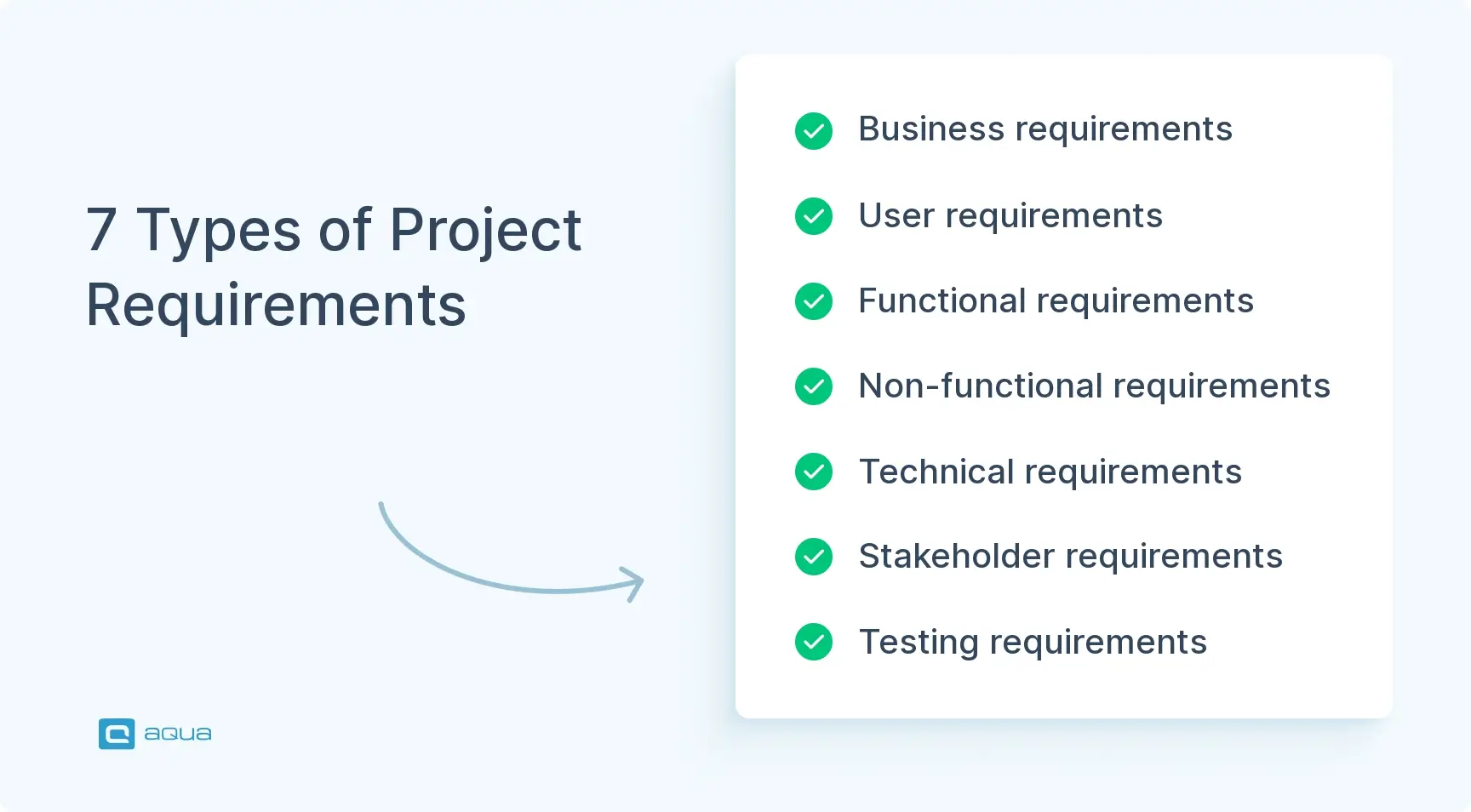Key takeaways
- Requirements fall into different categories that form a hierarchy. Business requirements sit at the top, and technical specifications sit at the bottom.
- Functional requirements describe what a system must do. Agile teams typically capture them as user stories or as specific system behaviors.
- Non-functional requirements define quality attributes like performance, security, and usability. They include measurable criteria such as uptime or time to load a page.
- Business requirements represent organizational objectives and the “why” behind a project. They focus on desired outcomes like customer retention.
- Testing requirements create a framework for validation across multiple dimensions. These include functionality, performance, security, and usability testing.
Project requirements may conflict, which intensifies speed, quality, cost, and scope constraints. Understanding requirement types gives you a framework for prioritizing strategically. Discover how to balance critical trade-offs 👇
1. Testing Requirements
Testing requirements are specifications that define what needs to be validated, how validation should occur, and what criteria determine whether the system is ready for release. They are used to create test cases that validate the software’s functionality and performance.
Testing requirements typically specify:
- Test scope and objectives: What aspects of the system need validation and why.
- Entry and exit criteria: Conditions that must be met before testing begins and conditions that determine when testing is complete.
- Test environment specifications: The infrastructure, data, and configuration needed for accurate testing.
- Acceptance criteria: Measurable standards that define when a requirement has been successfully validated.
- Test data requirements: Specific data sets, volumes, or conditions needed to properly exercise system functionality.
When you get your testing requirements right, your stakeholders, developers, and QA team all understand what success looks like. You have criteria, which means less debate about whether something is “done” and more clarity about what “good” actually means.
2. Functional Requirements
Functional requirements describe what a system must do. They specify the behaviors, capabilities, and functions it should perform under certain conditions. Think of them as defining the core purpose of your system and outlining how it interacts with users and other systems to deliver value.
Functional requirements form the foundation of any system design because they directly address user needs and business objectives. While other requirement types focus on qualities or constraints, functional requirements specify concrete actions and responses. They answer essential questions like: What features will users need? What data must be processed? What outputs should be generated? Without clear functional requirements, development teams lack direction about what they’re actually building.
Think of functional requirements as the “verbs” of your system. They describe the actions it takes. For example, an e-commerce application might have functional requirements like “The system shall allow users to add items to a shopping cart” or “The system shall calculate tax based on shipping address.” Each functional requirement typically follows a structure that identifies the actor, the action, and the result or condition.
Here are some key categories of functional requirements you’ll commonly encounter:
- User interface requirements: Specify what the user sees and interacts with, including screens, buttons, fields, and navigation
- Data management requirements: Define how information is captured, stored, processed, and retrieved
- Business process requirements: Outline workflows, rules, and operational sequences the system must support
- Reporting requirements: Detail what information must be extracted and formatted for output
- Integration requirements: Describe how the system must interact with other applications or services
- Security function requirements: Specify authentication, authorization, and other security behaviors
- Administrative function requirements: Define system management capabilities like configuration options
In Agile methodologies, software functional requirements are often captured as user stories. These stories follow the format “As a [role], I want [capability] so that [benefit].” This keeps everyone focused on real user needs while still clarifying what the system should do. In more traditional setups, you’d often see these same requirements written as detailed “shall” statements. Agile user stories just make it easier for teams to stay connected to the human side of the project.
Wouldn’t it be ideal to have a system that naturally supports all these requirement types while maintaining clear traceability between them? aqua cloud does exactly that by offering requirements management with end-to-end visual traceability. With aqua, you can easily document business, functional, and non-functional requirements in structured hierarchies. You can maintain direct links to test cases, scenarios, and defects. The platform’s AI-powered capabilities take this further. aqua’s domain-trained AI Copilot can generate detailed requirements from simple notes. At the same time, centralized documentation makes collaboration more straightforward. More than that, real-time dashboards visualize coverage and relationships. This helps you identify gaps early on.
Achieve 100% requirements coverage with aqua cloud’s powerful AI-driven platform
3. Non-Functional Requirements
Non-functional requirements (NFRs) define how well a system performs its functions. They specify quality attributes rather than specific behaviors or features. While functional requirements tell you what a system does, non-functional requirements establish the standards for how well it should do those things.
These requirements address the qualities that make a system usable, reliable, and effective in real-world conditions. They cover aspects like performance, security, scalability, availability, and usability. Your system might perfectly fulfill all its functional requirements yet still fail to meet user expectations if you don’t properly address the non-functional ones.
Consider a banking application that allows users to transfer money (functional requirement). The non-functional requirements would specify, for example, that transfers must complete within three seconds, the system must be available 99.9% of the time, it must handle 10,000 concurrent users, and it must meet specific security standards. These qualities often make the difference between a system users embrace and one they reject.
Non-functional requirements typically fall into several key categories:
- Performance requirements: Define response times, throughput, and processing capacity.
- Scalability requirements: Specify how the system must grow to handle increased loads.
- Availability requirements: Establish uptime expectations and acceptable downtime.
- Security requirements: Define protection measures for data and operations.
- Usability requirements: Specify ease of use and user experience standards.
- Maintainability requirements: Establish how easily the system can be updated and fixed.
- Reliability requirements: Define failure rates and recovery capabilities.
- Compatibility requirements: Specify integration with existing systems and standards.
Non-functional requirements should be measurable and testable. Vague statements like “the system should be fast” provide little value. Specific criteria like “search results shall return within 1.5 seconds for 95% of queries” create clear expectations that can be objectively verified.
These requirements often involve trade-offs. Improving security might reduce performance. Increasing scalability might increase complexity and cost. You need to prioritize non-functional requirements based on business value and user impact. Different types of systems emphasize different qualities: a financial system prioritizes security and accuracy, while a social media platform emphasizes performance and availability.
4. Business Requirements
Business requirements define what your organization wants to achieve and why a project matters in the first place. They capture the business objectives, not the technical details of how a system will function. Think of them as the “why” behind your investment of time, money, and resources.
These requirements usually come from executive leadership, business stakeholders, or strategic planning sessions. They express high-level goals in terms that matter to the business: financial metrics, market position, or operational improvements. A business requirement might state “Reduce customer support costs by 25%” or “Increase market share in the Asia-Pacific region by 10%.” Notice how these focus on measurable business impacts, not technical capabilities.
Business requirements do some important work for your project. First, they establish clear success criteria that go beyond technical implementation details. Second, they give your team the context needed to make smart decisions when facing trade-offs or unexpected changes. Third, they connect technical work to organizational strategy, which keeps everyone focused on delivering genuine business value.
Key characteristics of well-formed business requirements include:
- A focus on the “why” behind the initiative, not the “what” or “how.”
- Definition of objectives without tying them to a specific solution.
- Clear measurability, showing the business value or expected outcomes.
- Stability over time, even as detailed requirements evolve.
- Clarity that allows non-technical stakeholders to easily understand them.
For example, a business requirement might state: “Increase customer retention rates by 15% within 12 months” or “Reduce order processing costs by 30% while maintaining accuracy rates.” Note how these requirements specify desired business outcomes without dictating how those outcomes should be achieved.
Business requirements tend to remain stable throughout a project lifecycle. However, the approach to achieving those objectives might evolve based on new information, market changes, or technical discoveries. This stability makes business requirements an anchor point for managing project scope and priorities.
Hidden requirements often arise from assumptions, overlooked details, or implicit expectations. These can include usability considerations, edge cases, scalability needs, compliance standards, or even the unspoken priorities of stakeholders.
5. User Requirements
User requirements describe what users need to accomplish with a system. They capture goals, tasks, and expectations from the perspective of people who will directly interact with the solution. These requirements focus on user outcomes rather than system capabilities or business metrics.
Effective user requirements are discovered through direct engagement with actual users. Methods include interviews, observations, surveys, focus groups, and analysis of existing workflows. The goal is to understand what users say they want as well as what they truly need to be successful. Sometimes users articulate specific features they believe will help them. However, deeper exploration might reveal underlying needs that different solutions could address more effectively.
User requirements typically take different forms depending on the development methodology:
- User stories: Brief, structured statements in the format “As a [user role], I want [capability] so that [benefit]”
- Use cases: Detailed scenarios describing interactions between users and the system to achieve specific goals
- User personas: Fictional but research-based representations of typical users, including their goals and behaviors
- User journeys: Visual or narrative depictions of how users will progress through a system to complete their objectives
Well-formed user requirements share several important characteristics:
- They’re written from the user’s perspective, not the developer’s or organization’s view
- They focus on user goals and benefits rather than system features
- They consider the context in which users will interact with the system
- They avoid technical language unless users themselves would use such terminology
- They’re testable through user acceptance criteria or satisfaction measures
Your user requirements should be prioritized based on factors like frequency of use, number of affected users, and impact on user success. Not all user needs to carry the same weight. Some requirements represent core functionality that enables primary use cases, while others address edge cases or convenience features. Understanding these distinctions helps your team focus on what matters most to users.
6. Technical Requirements
Technical requirements define the specific technological attributes, constraints, and standards that your system must adhere to. These requirements translate user and business needs into technical specifications that guide the actual development and implementation of the solution.
Technical requirements create a connection between what users need and how developers will build it. They convert high-level concepts into concrete technical specifications that can be directly implemented. For instance, a user requirement stating “customers must be able to access their account information securely from mobile devices” might translate to technical requirements specifying “the system shall implement OAuth 2.0 authentication” and “the application must be compatible with iOS 14+ and Android 10+.”
These requirements typically emerge later in the requirements gathering process, after business and user needs are well understood. Solution architects, technical leads, security specialists, and other technical stakeholders usually define them. Technical requirements often need to balance competing factors like performance, cost, security, and development timeline.
Technical requirements generally fall into several categories:
- Technology stack requirements: Specified programming languages, frameworks, and platforms
- Infrastructure requirements: Hardware, cloud services, networking, and hosting specifications
- Integration requirements: APIs, protocols, and data exchange formats for connecting with other systems
- Technical constraints: Regulatory compliance needs, legacy system compatibility, or corporate standards
- Technical performance requirements: Processing capacity, throughput, response time, and resource utilization
- Technical security requirements: Authentication mechanisms, encryption methods, and access control specifications
- System quality attributes: Modularity, maintainability, testability, and other architectural qualities
Well-formed technical requirements are specific, measurable, and verifiable. Instead of vague statements like “the system must be scalable,” effective technical requirements provide concrete specifications such as “the database must support at least 1000 concurrent users with response times under 100ms for standard queries.”
Technical requirements often appear in documents like:
- System requirement specifications (SRS)
- Technical design documents
- Architecture definition documents
- Interface control documents
- Development standards and guidelines
Technical requirements must remain traceable to higher-level business and user requirements. This traceability ensures that technical decisions serve actual business and user needs rather than technology preferences alone. When trade-offs must be made, understanding how technical requirements connect to business value helps teams make informed decisions. You can better prioritize alternatives when you see the connection to business objectives.
7. Stakeholder Requirements
Stakeholder requirements capture the diverse needs, expectations, and constraints of all parties with a vested interest in your project or system. While user requirements focus solely on end-users, stakeholder requirements encompass a broader range of perspectives. Executives, regulators, operations teams, maintenance staff, and other groups affected by the system are included.
Stakeholder requirements provide a view of what success looks like from multiple angles. They ensure that a project doesn’t optimize for one group at the expense of others. For example, users might prioritize new features and capabilities, while IT operations stakeholders might emphasize maintainability and compatibility with existing systems. Compliance stakeholders focus on regulatory adherence.
Identifying and documenting stakeholder requirements requires systematic stakeholder analysis. This process identifies all relevant stakeholders, assesses their level of influence and interest, and establishes appropriate engagement strategies. Effective stakeholder requirement gathering involves tailored communication approaches for different groups, ranging from executive interviews to technical workshops to formal regulatory reviews.
I see this way to often when I coach people, there is no documentation or requirements and people tend to go by intuition. Sometimes you almost have too. But I strongly recommend not doing it, unless you just note down your intuition questions to ask them later but never use intuition to assume the product works like that.
Stakeholder requirements often address concerns such as:
- Operational requirements: How the system will be managed, monitored, and supported
- Transition requirements: How implementation will occur with minimal disruption
- Regulatory requirements: How compliance with laws and industry standards will be maintained
- Training requirements: How users and support teams will learn to use the system
- Business constraint requirements: Budget limitations, schedule demands, and resource restrictions
- Political requirements: Organizational dynamics, power structures, and approval processes
Stakeholder requirements often conflict with each other. For example, the finance team may focus on cutting costs, marketing may push for faster release, while security demands a more comprehensive testing process. Managing requirements well means balancing these priorities through clear negotiation and smart prioritization.
Well-documented stakeholder requirements typically include:
- The stakeholder group or role
- Their specific needs or expectations
- The business justification for those needs
- Priority or importance level
- Acceptance criteria for satisfaction
- Potential conflicts with other requirements
For example, a stakeholder requirement might state: “The compliance team requires that all customer data processing adhere to GDPR standards and generate auditable logs of all access and modifications.” This clearly identifies the stakeholder group, their need, and implies both functional and non-functional requirements that must be addressed.
Your stakeholder requirements should be validated with the stakeholders themselves before being used as input for other requirement types. This validation helps ensure that all perspectives are accurately represented and creates buy-in from diverse groups. Regular stakeholder reviews throughout the project lifecycle help maintain alignment as requirements evolve.

Comparison of Requirement Types
The table below summarizes the key characteristics of each requirement type we’ve covered. It shows how they differ in focus, purpose, format, and stability. This comparison, created by aqua, should help you understand which requirement type to use in different situations and how they work together in the requirements hierarchy.
| Requirement Type | Focus | Answers | Typical Format | Key Stakeholders | Stability | Example |
|---|---|---|---|---|---|---|
| Testing Requirements | Validation approach | How we’ll verify it | Test scenarios, acceptance criteria | QA engineers, test managers | Medium-low | “All financial calculations must be tested with at least 10,000 randomized transaction sets” |
| Functional Requirements | System behaviors | What the system does | Shall statements, use cases | Business analysts, systems engineers | Medium-low | “The system shall automatically recalculate inventory levels after each transaction” |
| Non-functional Requirements | Quality attributes | How well it performs | Measurable quality criteria | Architects, quality engineers | Medium | “The system shall respond to standard queries in under 0.5 seconds during peak load” |
| Business Requirements | Strategic goals | Why we’re doing this | Vision statements, objectives | Executives, product owners | High | “Reduce customer support call volume by 30% within six months of deployment” |
| User Requirements | End-user needs | What users need to accomplish | User stories, scenarios | End users, product managers | Medium-high | “As a customer service representative, I need to access customer purchase history in one click” |
| Stakeholder Requirements | Varied perspectives | What different groups need | Stakeholder needs statements | All stakeholder groups | Medium | “The compliance team requires all transactions to be logged for 7 years per regulatory standards” |
| Technical Requirements | Implementation specifications | How it will be built | Technical specifications, standards | Solution architects, tech leads | Low | “The application will use React.js for the frontend and implement RESTful APIs with JSON” |
In essence, business requirements establish the “why.” User and stakeholder requirements define the “what” from different perspectives. Functional requirements specify the “what” in system terms. Non-functional and technical requirements address the “how well” and “how.” Notice that each requirement type has its appropriate level of detail and typical stability.
Managing the diverse types of requirements in requirement engineering may present a challenge for QA, dev, and product teams. That’s where aqua cloud can help. With aqua test management[https://aqua-cloud.io/test-management-solution/] platform, you can document and organize all requirement types in a single, centralized platform with powerful visualization tools. This ranges from high-level business objectives to detailed technical specifications. Aqua’s built-in AI Copilot is trained specifically on QA and testing knowledge. It automates requirement generation and enhancement and saves your team up to 12.8 hours per week. When requirements change as they inevitably do, aqua’s complete audit trails and version management provide the transparency needed for compliance.
Save 80% of the time spent on documentation with aqua's domain-trained AI
Conclusion
Your team has to work with both high-level business requirements that define strategy and detailed technical requirements that describe how to implement it. Each level matters, and skipping one can easily cause gaps or misunderstandings later. Understanding how these requirement types differ helps your team capture the right information at the right level of detail. Some teams maintain links between them manually, while others rely on requirement management tools. Either way, structuring your requirements correctly already sets your project up for success.

















